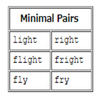Teaching Segmentals and Suprasegmentals
Michael Farquharson
This paper will focus on teaching activities for first year university students. The first section will deal with teaching /l/ and /r/ and the second section will deal with teaching information focus and rhythm. Our Japanese students have great difficulty with these areas because they are so intrinsically different from their own sound system. In Japan /l/ and /r/ are not distinguishable from one another and our students have a terrible time trying to produce these sounds as well as hearing them as distinct sounds. The second area that will be explored will be the teaching of rhythm and information focus in the classroom. Our Japanese students have trouble in this area too, because Japanese is a syllable-timed language and English is a stress-timed language. Here we will be looking at simple information focus and stress patterns in English sentences when reporting information.
One of the first things I like to do when introducing /l / and /r/ is to tell a few interesting and funny stories about mistakes in the pronunciation of /l/ and /r/. Depending upon the level and the situation, I might tell the class about an engineer from a major car company. He was my student in a company English conversation class. He had to go to Australia because of a problem with a brake shaft that was corroding. He went to a meeting with his Australian counterparts and gave his presentation on the problem. In the middle of his presentation, with one mistake in the articulation of /l/ and /r/ he became an overnight success as a comedian. He had tried to tell his counterparts about the severe problems that a rusty shaft could cause. Well there is no need to discuss here what happened in the meeting but I'm sure our own imaginations can take it from here.
The second anecdote that I might tell to all levels of students would be about my mother and her first visit to Japan. My mother does not like to fly and is usually quite nervous before the plane takes off. As my mother was boarding the plane a very polite flight attendant wished her a very nice flight except she was wished a nice fright.
Many Japanese speakers make mistakes with /l/ and /r/ and though classroom practice with minimal pairs and with communicative exercises might not dramatically reduce mistakes, the students can be made aware of the differences. It is hoped that though the teachers may or may not see great advances in this area of pronunciation they should not ignore the trouble spot. Helping the students recognize the differences and giving them practice may help them understand why an English speaker may not have understood what they were trying to communicate. With this understanding the students can then try again or try to find another way to explain, thus taking another step on the road of international communication in English.
To begin the lesson, I describe the differences between the production of /l/ and /r/. I like to exaggerate the articulation of these sounds. I usually get the students to put their hands on their cheeks and to pull their cheeks back for the production of /l/ and to bring them forward in the production of /r/. I then begin with minimal pairs. One of the pairs I use is for mother, I hope that the next time she comes to Japan she will have a good flight.

